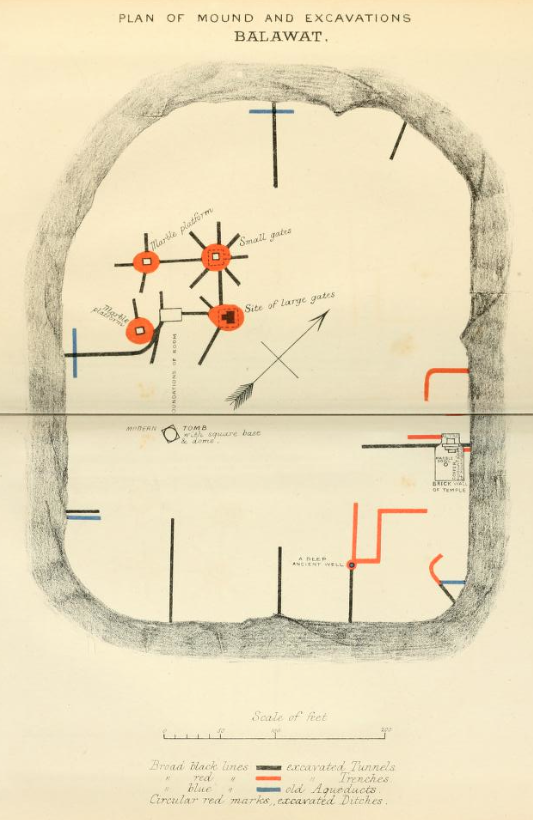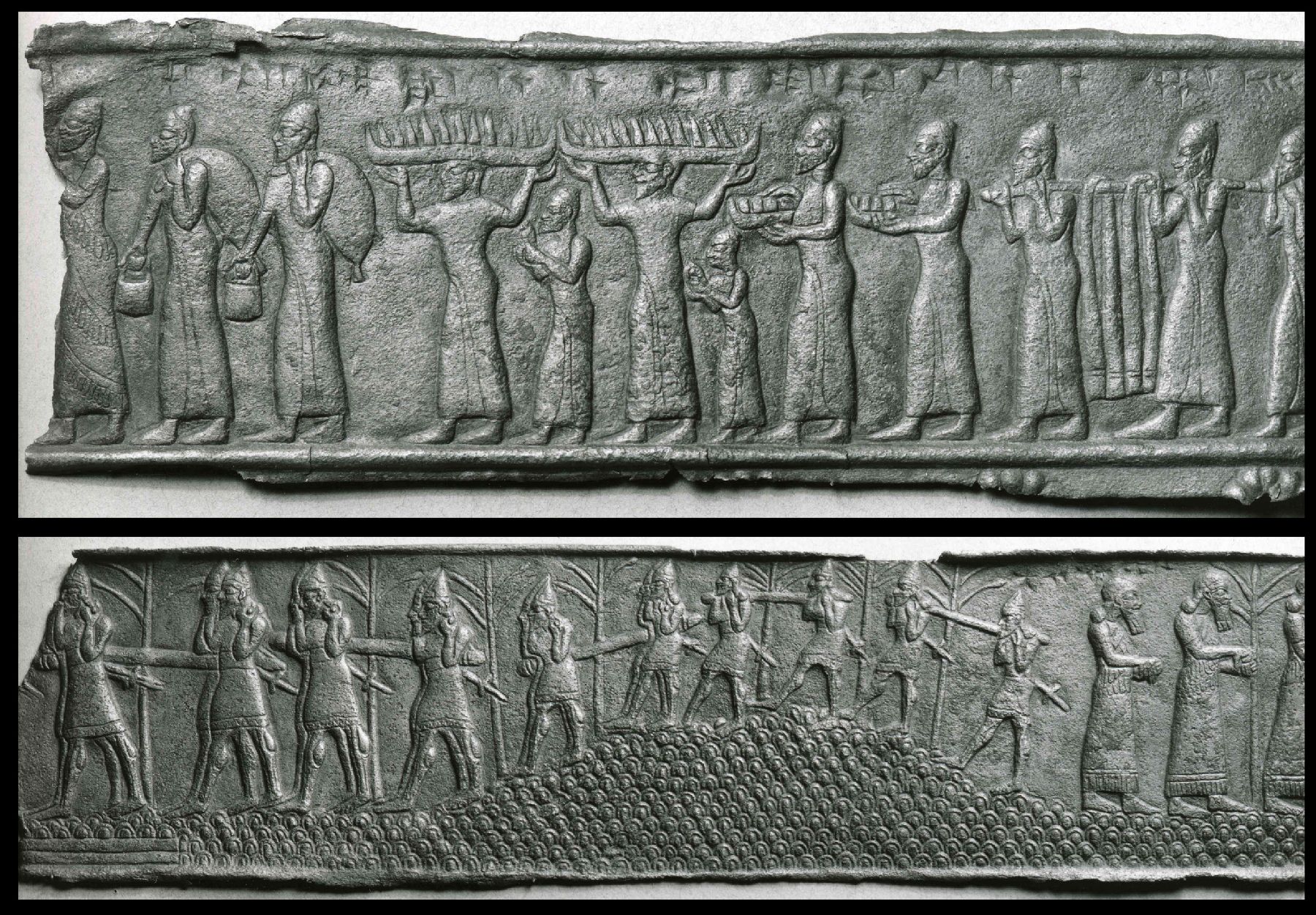Balawat on:
[Wikipedia]
[Google]
[Amazon]
Balawat (, ') is an
 The site was excavated in 1878 by archaeologist
The site was excavated in 1878 by archaeologist
 Aside from temples and palace buildings, the most important artifacts discovered there were the so-called Balawat Gates. The gates measured about 20 feet in height and belonged to the temple of Mamu, the god of dreams. These were made up of bronze bands attached through nails to two wooden gates of the palace. The bronze bands depict a sacrifice and war scenes from the campaigns of the Neo-Assyrian king
Aside from temples and palace buildings, the most important artifacts discovered there were the so-called Balawat Gates. The gates measured about 20 feet in height and belonged to the temple of Mamu, the god of dreams. These were made up of bronze bands attached through nails to two wooden gates of the palace. The bronze bands depict a sacrifice and war scenes from the campaigns of the Neo-Assyrian king
Unger, Eckhard, "Zum Bronzetor von Balawat, Beiträge zur Erklärung und Deutung der assyrischen Inschriften und Reliefs Salmanassars III", Leipzig, Pfeiffer, 1913 *Léonard W. King, "Bronze Reliefs from the Gates of Shalmanezer. King of Assyria BC 860-825", Longman's & Company, 1915 *Seton Lloyd, "Foundations in the Dust", 1947
Theophilus G Pinches and Walter de Gray Birch, The bronze ornaments of the palace gates of Balawat (Shalmaneser II, B.C. 859-825) edited, with an introduction by Walter de Gray Birch ; with descriptions and translations by Theophilus G. Pinches, Society of Great Russell Street, 1902
Theophilus G Pinches, "The Balawat Gates and Their Relation to Assyrian Art", The American Art Review, vol. 1, pp. 527–535, 1880
Bronze relief fragment at the Walters Art Museum
{{Authority control Populated places in Nineveh Governorate Archaeological sites in Iraq Ancient Assyrian cities Tells (archaeology) Assyrian communities in Iraq
archaeological site
An archaeological site is a place (or group of physical sites) in which evidence of past activity is preserved (either prehistoric or recorded history, historic or contemporary), and which has been, or may be, investigated using the discipline ...
of the ancient Assyrian city of Imgur-Enlil, and modern village in Nineveh Province (Iraq
Iraq, officially the Republic of Iraq, is a country in West Asia. It is bordered by Saudi Arabia to Iraq–Saudi Arabia border, the south, Turkey to Iraq–Turkey border, the north, Iran to Iran–Iraq border, the east, the Persian Gulf and ...
). It lies southeast from the city of Mosul
Mosul ( ; , , ; ; ; ) is a major city in northern Iraq, serving as the capital of Nineveh Governorate. It is the second largest city in Iraq overall after the capital Baghdad. Situated on the banks of Tigris, the city encloses the ruins of the ...
and to the south of the modern Assyrian town of Bakhdida.
Ancient name
Balawat is the site of the ancientAssyria
Assyria (Neo-Assyrian cuneiform: , ''māt Aššur'') was a major ancient Mesopotamian civilization that existed as a city-state from the 21st century BC to the 14th century BC and eventually expanded into an empire from the 14th century BC t ...
n city of Imgur-Enlil. The meaning of Imgur-Enlil is "Enlil agreed". Note that there was also a wall in ancient Babylon
Babylon ( ) was an ancient city located on the lower Euphrates river in southern Mesopotamia, within modern-day Hillah, Iraq, about south of modern-day Baghdad. Babylon functioned as the main cultural and political centre of the Akkadian-s ...
named Imgur-Enlil.
History of archaeological research
 The site was excavated in 1878 by archaeologist
The site was excavated in 1878 by archaeologist Hormuzd Rassam
Hormuzd Rassam (; ; 182616 September 1910) was an Assyriologist and author. He is known for making a number of important archaeological discoveries from 1877 to 1882, including the clay tablets that contained the ''Epic of Gilgamesh,'' the world ...
. The site was again excavated by Max Mallowan for the British School of Archaeology in Iraq in 1956. A surface survey was conducted by D. J. Tucker in 1989 for the British Museum. The town walls enclosed an area of around 64 hectares.
Occupation history
The city of Imgur-Enlil was founded by the Neo-Assyrian kingAshurnasirpal II
Ashur-nasir-pal II (transliteration: ''Aššur-nāṣir-apli'', meaning " Ashur is guardian of the heir") was the third king of the Neo-Assyrian Empire from 883 to 859 BC. Ashurnasirpal II succeeded his father, Tukulti-Ninurta II. His son and s ...
(884-859 BC). It lay up the Derrah river from the Tigris
The Tigris ( ; see #Etymology, below) is the eastern of the two great rivers that define Mesopotamia, the other being the Euphrates. The river flows south from the mountains of the Armenian Highlands through the Syrian Desert, Syrian and Arabia ...
, where the city of Kalhu (Biblical Nimrud
Nimrud (; ) is an ancient Assyrian people, Assyrian city (original Assyrian name Kalḫu, biblical name Calah) located in Iraq, south of the city of Mosul, and south of the village of Selamiyah (), in the Nineveh Plains in Upper Mesopotamia. ...
/Calah
Nimrud (; ) is an ancient Assyrian city (original Assyrian name Kalḫu, biblical name Calah) located in Iraq, south of the city of Mosul, and south of the village of Selamiyah (), in the Nineveh Plains in Upper Mesopotamia. It was a major ...
) was situated. Imgur-Enlil lay between the major Neo-Assyrian cities of Nineveh
Nineveh ( ; , ''URUNI.NU.A, Ninua''; , ''Nīnəwē''; , ''Nīnawā''; , ''Nīnwē''), was an ancient Assyrian city of Upper Mesopotamia, located in the modern-day city of Mosul (itself built out of the Assyrian town of Mepsila) in northern ...
and Arrapha (modern Kirkuk
Kirkuk (; ; ; ) is a major city in northern Iraq, serving as the capital of the Kirkuk Governorate. The city is home to a diverse population of Kurds, Iraqi Turkmen, Iraqi Turkmens and Arabs. Kirkuk sits on the ruins of the original Kirkuk Cit ...
) in the southeast along the royal Neo-Assyrian road. Ashurnasirpal II had already transferred the capital from Assur
Aššur (; AN.ŠAR2KI, Assyrian cuneiform: ''Aš-šurKI'', "City of God Aššur"; ''Āšūr''; ''Aθur'', ''Āšūr''; ', ), also known as Ashur and Qal'at Sherqat, was the capital of the Old Assyrian city-state (2025–1364 BC), the Midd ...
to Kalhu, and the foundation of Imgur-Enlil may have been a further step to knit up the Neo-Assyrian empire. Construction at the site continued under Ashurnasirpal II's son Shalmaneser III
Shalmaneser III (''Šulmānu-ašarēdu'', "the god Shulmanu is pre-eminent") was king of the Neo-Assyrian Empire from 859 BC to 824 BC.
His long reign was a constant series of campaigns against the eastern tribes, the Babylonians, the nations o ...
. The city existed for about two and a half centuries but was, like most Neo-Assyrian cities, sacked and destroyed by the Medes
The Medes were an Iron Age Iranian peoples, Iranian people who spoke the Median language and who inhabited an area known as Media (region), Media between western Iran, western and northern Iran. Around the 11th century BC, they occupied the m ...
, Babylonians
Babylonia (; , ) was an ancient Akkadian-speaking state and cultural area based in the city of Babylon in central-southern Mesopotamia (present-day Iraq and parts of Kuwait, Syria and Iran). It emerged as an Akkadian-populated but Amorite-ru ...
and Scythians
The Scythians ( or ) or Scyths (, but note Scytho- () in composition) and sometimes also referred to as the Pontic Scythians, were an Ancient Iranian peoples, ancient Eastern Iranian languages, Eastern Iranian peoples, Iranian Eurasian noma ...
during the fall of the Neo-Assyrian empire 614-605 BC.
Post U.S.-Iraq War construction
In November 2004, the village had roads constructed by theUnited States Army
The United States Army (USA) is the primary Land warfare, land service branch of the United States Department of Defense. It is designated as the Army of the United States in the United States Constitution.Article II, section 2, clause 1 of th ...
, which connected the modern Assyrian village to the ancient Assyrian city of Kalhu and the village of Bakhdida (Al Hamdaniyah.) The project was dubbed "Ninewa Village Roads Project" and was funded by the U.S. government. The contract to build the roads was given to the Ashour General Construction Contracting Company and cost $1,120,000.
Material culture
 Aside from temples and palace buildings, the most important artifacts discovered there were the so-called Balawat Gates. The gates measured about 20 feet in height and belonged to the temple of Mamu, the god of dreams. These were made up of bronze bands attached through nails to two wooden gates of the palace. The bronze bands depict a sacrifice and war scenes from the campaigns of the Neo-Assyrian king
Aside from temples and palace buildings, the most important artifacts discovered there were the so-called Balawat Gates. The gates measured about 20 feet in height and belonged to the temple of Mamu, the god of dreams. These were made up of bronze bands attached through nails to two wooden gates of the palace. The bronze bands depict a sacrifice and war scenes from the campaigns of the Neo-Assyrian king Shalmaneser III
Shalmaneser III (''Šulmānu-ašarēdu'', "the god Shulmanu is pre-eminent") was king of the Neo-Assyrian Empire from 859 BC to 824 BC.
His long reign was a constant series of campaigns against the eastern tribes, the Babylonians, the nations o ...
(859-824 BC), and were the first depictions of landscape elements (such as trees and mountains) in Assyrian art.
See also
*List of cities of the ancient Near East
The earliest cities in history were in the ancient Near East, an area covering roughly that of the modern Middle East: its history began in the 4th millennium BC and ended, depending on the interpretation of the term, either with the conquest by ...
References
Further reading
*Billerbeck, A./Delitzsch, F., "Die Palasttore Salmanassars II von Balawat", Erklärung ihrerBilder und Inschriften, BA 6/1, Leipzig, 1908 *J.E. Curtis et al., "The Balawat Gates of Ashurnasirpal II", British Museum Press, 2008,Unger, Eckhard, "Zum Bronzetor von Balawat, Beiträge zur Erklärung und Deutung der assyrischen Inschriften und Reliefs Salmanassars III", Leipzig, Pfeiffer, 1913 *Léonard W. King, "Bronze Reliefs from the Gates of Shalmanezer. King of Assyria BC 860-825", Longman's & Company, 1915 *Seton Lloyd, "Foundations in the Dust", 1947
Theophilus G Pinches and Walter de Gray Birch, The bronze ornaments of the palace gates of Balawat (Shalmaneser II, B.C. 859-825) edited, with an introduction by Walter de Gray Birch ; with descriptions and translations by Theophilus G. Pinches, Society of Great Russell Street, 1902
Theophilus G Pinches, "The Balawat Gates and Their Relation to Assyrian Art", The American Art Review, vol. 1, pp. 527–535, 1880
External links
Bronze relief fragment at the Walters Art Museum
{{Authority control Populated places in Nineveh Governorate Archaeological sites in Iraq Ancient Assyrian cities Tells (archaeology) Assyrian communities in Iraq